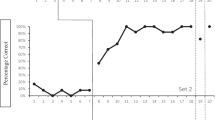Abstract
We employed a flashcard strategy to teach two high school students with mental retardation their math facts. The study was carried out in a typical self-contained classroom public school setting. We measured both correct responses and errors. The effects of employing flashcards were examined in a multiple baseline design across participants. Overall outcomes indicated that when flashcards were employed there was an increase in their correct rate and a decrease in errors. Applicability of employing flashcards was discussed.

Similar content being viewed by others
References
Bender, M., & Valletutti, P. J. (1982). Teaching functional academics: A curriculum guide for adolescents and adults with learning problems. Baltimore: University Park Press.
Brown, L., Branston, M. B., Hamre-Nietupeski, S. Pumpian, I., Certo, N., & Gruenewald, L. (1979). A strategy for developing chronological age-appropriate and functional curricular content for severely handicapped adolescents and young adults. The Journal of Special Education, 13, 81–90.
Cipani, E. (Ed.) (1988). Transitioning exceptional children and youth into the community: Research and practice. New York: Haworth Press.
Colyer, S. P., & Collins, B. C. (1996). Using natural cues within prompt levels to teach the next dollar strategy to students with disabilities. Journal of Special Education, 30, 305–318.
Delli Sante, A., McLaughlin, T. F., & Weber, K. P. (2001). Use and evaluation of a Direct Instruction flashcard strategy on multiplication math facts mastery with two students with developmental disabilities and attention deficit disorder. Journal of Precision Teaching and Celeration, 27(2), 68–75.
Duvall, T., McLaughlin, T. F., & Cooke-Sederstrom, G. (2003). The differential effects of skip counting and previewing on the accuracy and fluency of math facts with middle school students with learning disabilities. International Journal of Special Education, 18(1), 1–7.
Hastings, F. L., Raymond, G., & McLaughlin, T. F. (1989). Speed money counting: The use of direct instruction to train disabled and mentally retarded adolescents to count money efficiently. B. C. Journal of Special Education, 13, 137–146.
Hayden, J., & McLaughlin, T. F. (2004). The effects of cover, copy, and compare and flashcard drill on correct rate of math facts for a middle school student with learning disabilities. Journal of Precision Teaching and Celeration, 20(1), 17–21.
Heward, W. L. (1994). Three “low tech” strategies to increase the frequency of active student responses during group instruction In R. Gardner III, D. Sainato, J. O. Cooper, T. E. Heron, W. L. Heward, J. Eshleman, & T. Grassi. (Eds.), Behavior analysis in education: Focus on measureably superior instruction (pp. 283–320). Monterey, CA: Brooks/Cole.
Heward, W. L. (2006). Teaching exceptional children (8th ed.). Upper Saddle River, NJ: Prentice-Hall.
Kazdin, A. E. (1977). Assessing the clinical and applied significance of behavior change through social validation. Behavior Modification, 1, 427–452.
Kazdin, A. E. (1982). Single case research designs: Methods for clinical and applied settings. New York: Oxford University Press.
Kuntz, K. J., McLaughlin, T. F., & Howard, V. F. (2001). A comparison of cooperative learning and small group individualized instruction for math in a self contained classroom for elementary students with disabilities. Educational Research Quarterly, 24(3), 41–56.
McLaughlin, T. F. (1983). An examination and evaluation of single subject designs used in behavior analysis research in school settings. Educational Research Quarterly, 7, 35–42.
McLaughlin, T. F., & Skinner, C. H. (1996). Improving academic performance through self-management: Cover, copy, and compare. Intervention in School and Clinic, 32, 113–118.
McLaughlin, T. F., Williams, B. F., Williams, R. L., Peck, S. M., Derby, K. M., Bjordahl, J. M., et al. (1999). Behavioral training for teachers in special education: The Gonzaga University program. Behavioral Interventions, 14, 83–134.
Marchand-Martella, N. E., Slocum, T. A., & Martella, R. C. (Eds.) (2004). Introduction to direct instruction. Boston, MA: Pearson Education, Inc.
Polya, G. (2002). Goals of mathematical education: Part 1. Mathematics Teaching, 181, 6–7.
Stein, M, Kinder, D., Silbert, J., & Carnine, D. W. (2006). Designing effective mathematics instruction, A direct instruction math (4th ed). Upper Saddle River, NJ: Pearson Education Inc.
Woodcock, R. W., & Johnson, M. B. (1989). Woodcock–Johnson psycho-educational battery. Chicago: Riverside.
Author information
Authors and Affiliations
Corresponding author
Additional information
Preparation of this manuscript was in partial fulfillment of the requirements of Shannon Hayter for a Bachelor of Education in Special Education from Gonzaga University, Spokane, WA.
Rights and permissions
About this article
Cite this article
Hayter, S., Scott, E., McLaughlin, T.F. et al. The Use of a Modified Direct Instruction Flashcard System with Two High School Students with Developmental Disabilities. J Dev Phys Disabil 19, 409–415 (2007). https://doi.org/10.1007/s10882-007-9059-3
Published:
Issue Date:
DOI: https://doi.org/10.1007/s10882-007-9059-3




